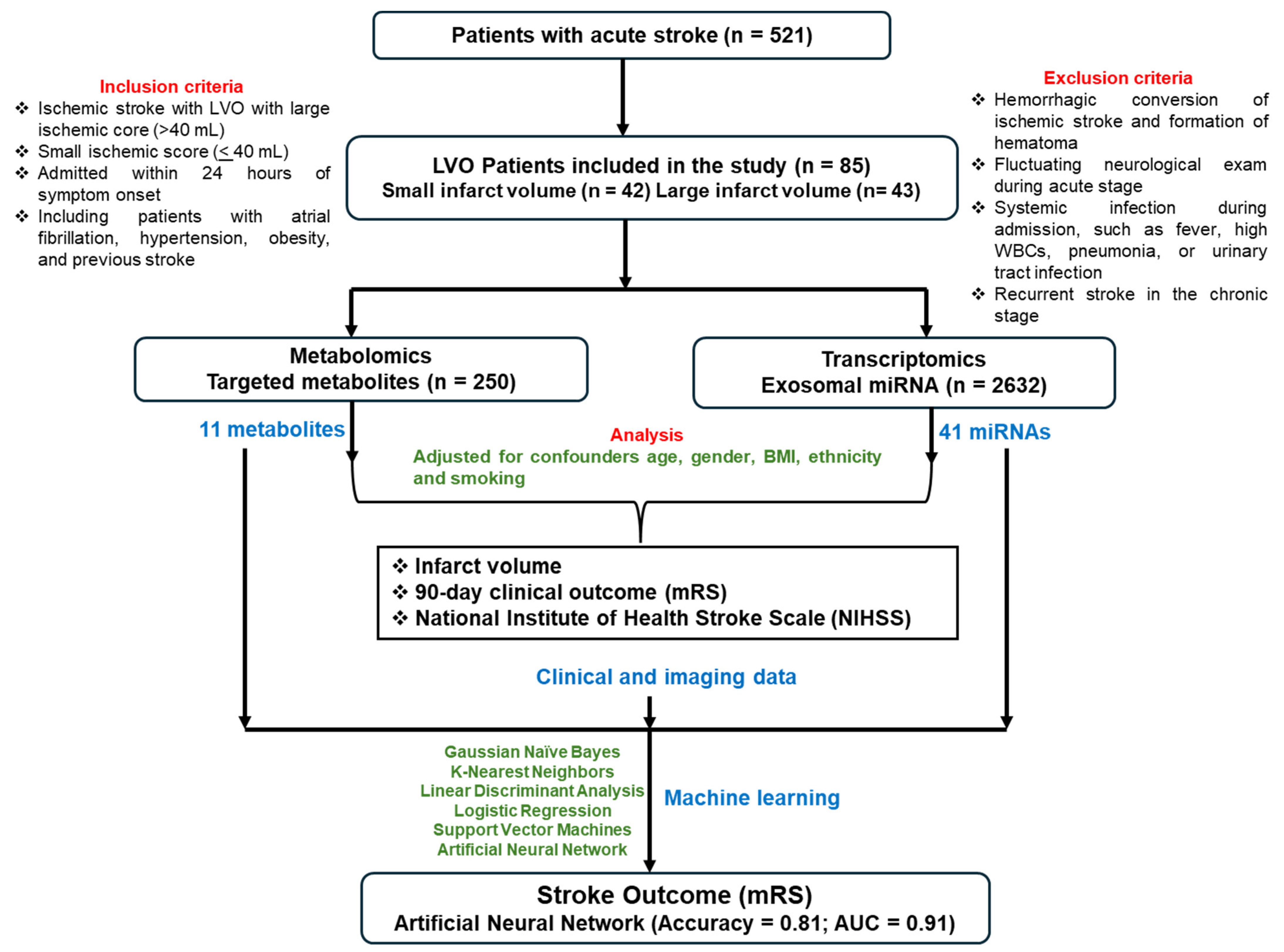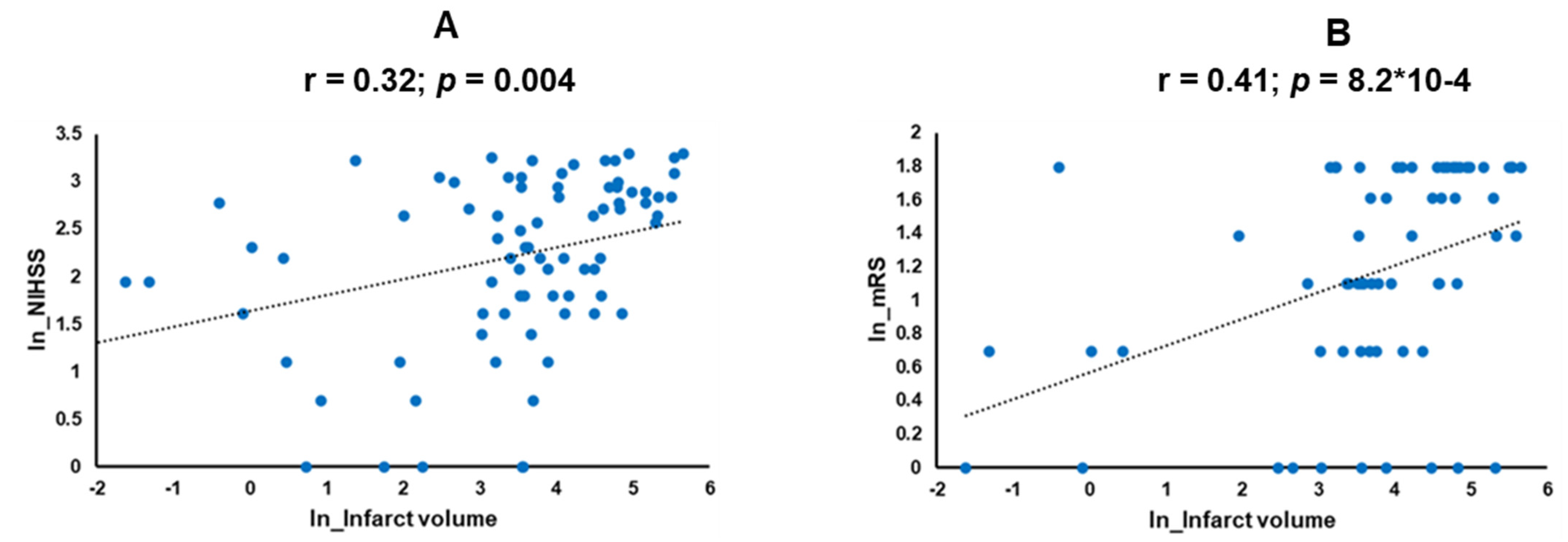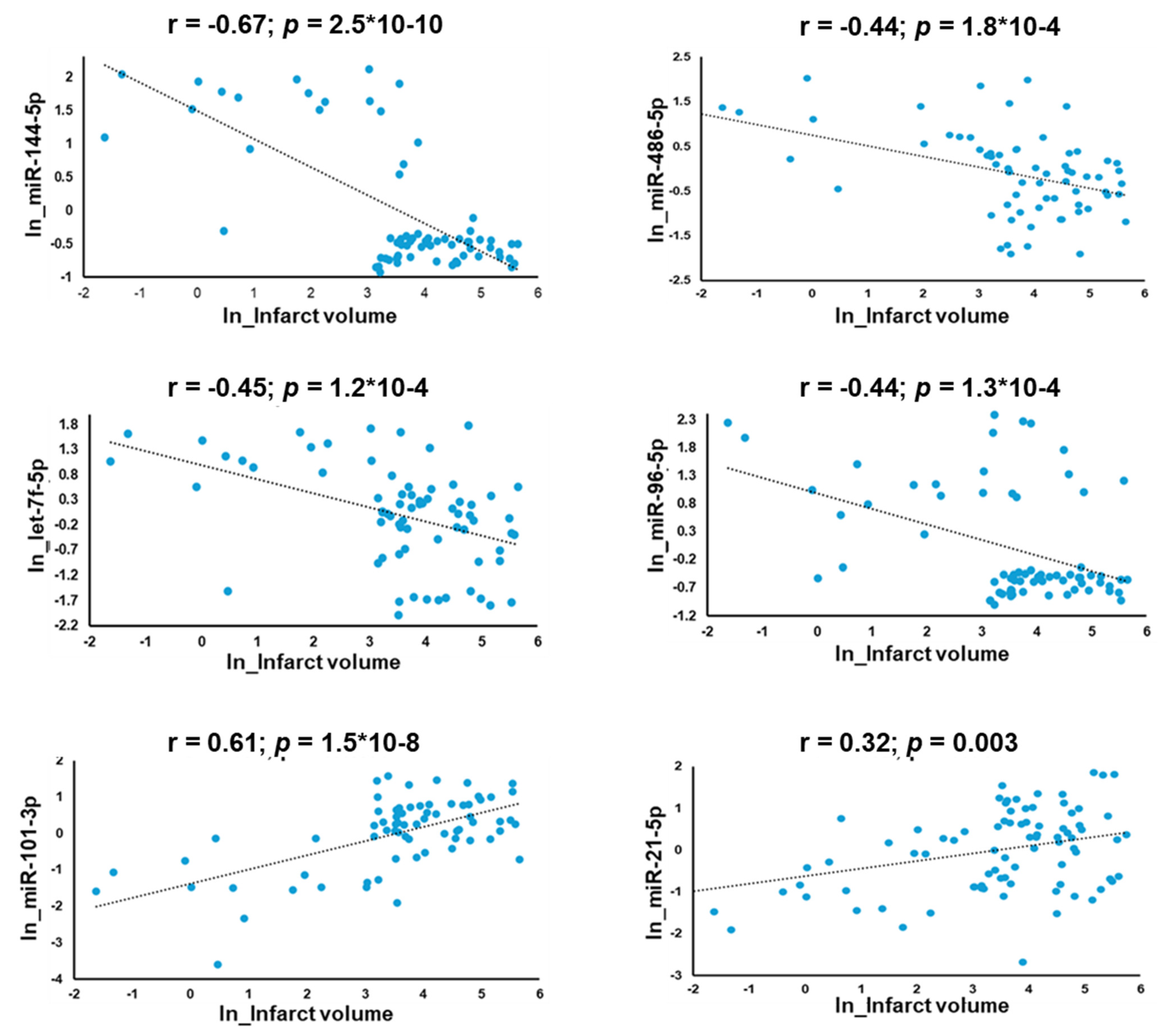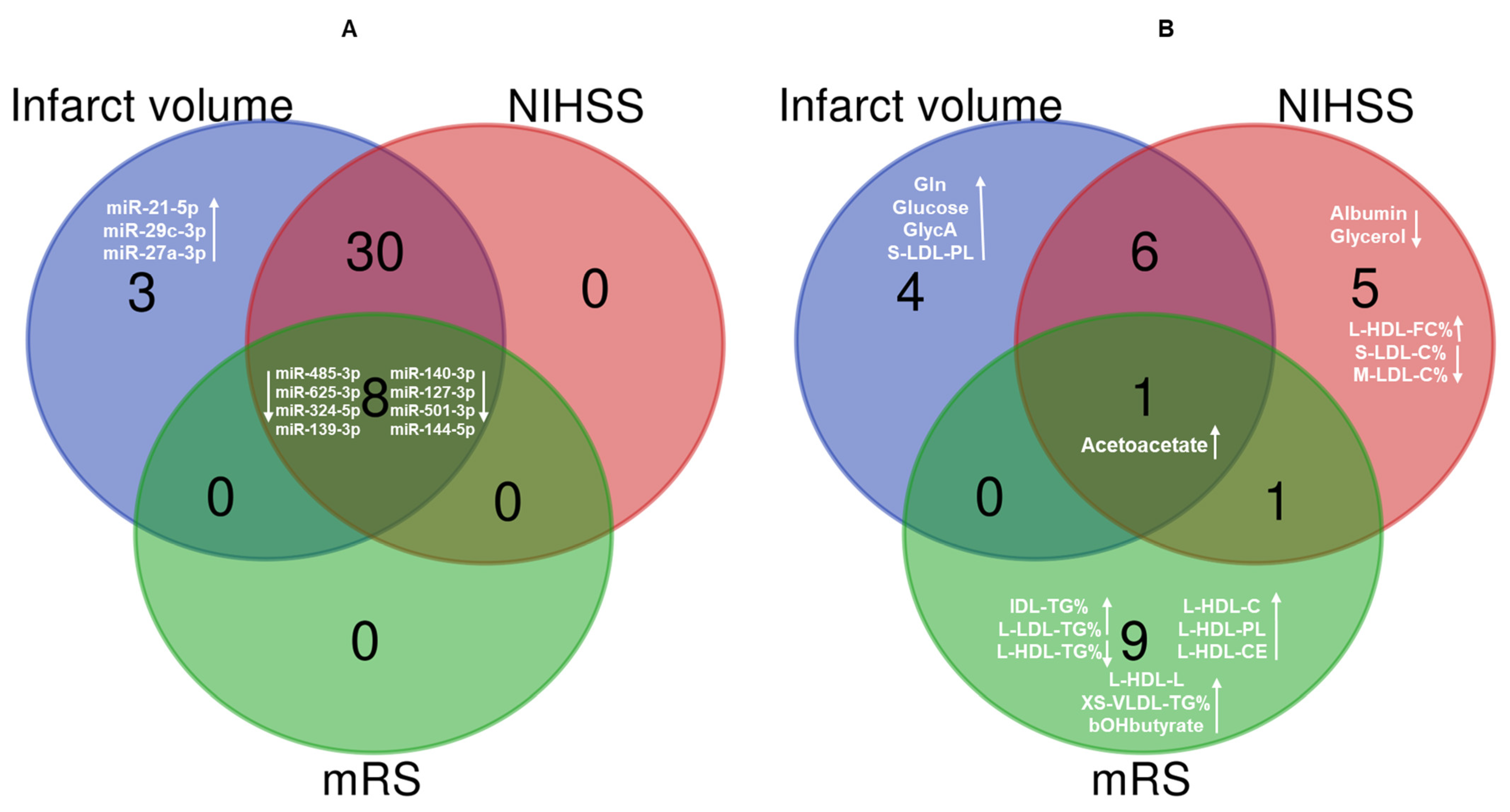Improving Stroke Outcome Prediction Using Molecular and Machine Learning Approaches in Large Vessel Occlusion
Abstract
:1. Introduction
2. Experimental Procedure
2.1. Study Participants
2.2. Neuroimaging, Infarct Volume and Clinical Outcome
2.3. Metabolome Analysis
2.4. Exosome Extraction and RNA Isolation
2.5. miRNA Sequencing Quality Control (QC) and Analysis
2.6. Statistical Analysis
2.7. Machine Learning
3. Results
3.1. Discovery of Significantly Altered Patterns of Circulating miRNAs Associated with Infarct Volume
3.2. Association of miRNAs with NIHSS and Stroke Outcome (mRS Score)
3.3. Discovery of Significantly Altered Patterns of Serum Metabolites with Infarct Volume
3.4. Association of Metabolites with NIHSS and Stroke Outcomes (mRS)
3.5. Association of Exosomal miRNAs with Metabolites
3.6. Machine Learning Analysis
4. Discussion
Study Strengths and Limitations
5. Conclusions
Supplementary Materials
Author Contributions
Funding
Institutional Review Board Statement
Informed Consent Statement
Data Availability Statement
Acknowledgments
Conflicts of Interest
References
- Feigin, V.L.; Stark, B.A.; Johnson, C.O.; Roth, G.A.; Bisignano, C.; Abady, G.G.; Abbasifard, M.; Abbasi-Kangevari, M.; Abd-Allah, F.; Abedi, V.; et al. Global, regional, and national burden of stroke and its risk factors, 1990-2019: A systematic analysis for the Global Burden of Disease Study 2019. Lancet Neurol. 2021, 20, 795–820. [Google Scholar] [CrossRef] [PubMed]
- Qin, H.; Wang, P.; Zhang, R.; Yu, M.; Zhang, G.; Liu, G.; Wang, Y. Stroke History is an Independent Risk Factor for Poor Prognosis in Ischemic Stroke Patients: Results from a Large Nationwide Stroke Registry. Curr. Neurovasc. Res. 2020, 17, 487–494. [Google Scholar] [CrossRef] [PubMed]
- Yang, Y.H.; Lei, L.; Bao, Y.P.; Zhang, L. An Integrated Metabolomic Screening Platform Discovers the Potential Biomarkers of Ischemic Stroke and Reveals the Protective Effect and Mechanism of Folic Acid. Front. Mol. Biosci. 2022, 9, 783793. [Google Scholar] [CrossRef] [PubMed]
- Virani, S.S.; Alonso, A.; Benjamin, E.J.; Bittencourt, M.S.; Callaway, C.W.; Carson, A.P.; Chamberlain, A.M.; Chang, A.R.; Cheng, S.; Delling, F.N.; et al. Heart Disease and Stroke Statistics-2020 Update: A Report From the American Heart Association. Circulation 2020, 141, e139–e596. [Google Scholar] [CrossRef]
- Turc, G.; Maier, B.; Naggara, O.; Seners, P.; Isabel, C.; Tisserand, M.; Raynouard, I.; Edjlali, M.; Calvet, D.; Baron, J.C.; et al. Clinical Scales Do Not Reliably Identify Acute Ischemic Stroke Patients With Large-Artery Occlusion. Stroke 2016, 47, 1466–1472. [Google Scholar] [CrossRef]
- Rai, A.T.; Seldon, A.E.; Boo, S.; Link, P.S.; Domico, J.R.; Tarabishy, A.R.; Lucke-Wold, N.; Carpenter, J.S. A population-based incidence of acute large vessel occlusions and thrombectomy eligible patients indicates significant potential for growth of endovascular stroke therapy in the USA. J. Neurointerv. Surg. 2017, 9, 722–726. [Google Scholar] [CrossRef]
- Hiraga, A.; Yamaoka, T.; Sakai, Y.; Osakabe, Y.; Suzuki, A.; Hirose, N. Relationship between outcome in acute stroke patients and multiple stroke related scores obtained after onset of stroke. J. Phys. Ther. Sci. 2018, 30, 1310–1314. [Google Scholar] [CrossRef]
- Menezes, N.M.; Ay, H.; Wang Zhu, M.; Lopez, C.J.; Singhal, A.B.; Karonen, J.O.; Aronen, H.J.; Liu, Y.; Nuutinen, J.; Koroshetz, W.J.; et al. The real estate factor: Quantifying the impact of infarct location on stroke severity. Stroke 2007, 38, 194–197. [Google Scholar] [CrossRef]
- Rottiers, V.; Naar, A.M. MicroRNAs in metabolism and metabolic disorders. Nat. Rev. Mol. Cell Biol. 2012, 13, 239–250. [Google Scholar] [CrossRef]
- Vasudeva, K.; Munshi, A. miRNA dysregulation in ischaemic stroke: Focus on diagnosis, prognosis, therapeutic and protective biomarkers. Eur. J. Neurosci. 2020, 52, 3610–3627. [Google Scholar] [CrossRef]
- Gu, R.F.; Fang, T.; Nelson, A.; Gyoneva, S.; Gao, B.; Hedde, J.; Henry, K.; Peterson, E.; Burkly, L.C.; Wei, R. Proteomic Characterization of the Dynamics of Ischemic Stroke in Mice. J. Proteome Res. 2021, 20, 3689–3700. [Google Scholar] [CrossRef] [PubMed]
- Ruan, J.; Yao, Y. Behavioral tests in rodent models of stroke. Brain Hemorrhages 2020, 1, 171–184. [Google Scholar] [CrossRef] [PubMed]
- Sidorov, E.; Bejar, C.; Xu, C.; Ray, B.; Reddivari, L.; Chainakul, J.; Vanamala, J.K.P.; Sanghera, D.K. Potential Metabolite Biomarkers for Acute Versus Chronic Stage of Ischemic Stroke: A Pilot Study. J. Stroke Cerebrovasc. Dis. 2020, 29, 104618. [Google Scholar] [CrossRef] [PubMed]
- Sidorov, E.; Sanghera, D.K.; Vanamala, J.K.P. Biomarker for Ischemic Stroke Using Metabolome: A Clinician Perspective. J. Stroke 2019, 21, 31–41. [Google Scholar] [CrossRef]
- Sidorov, E.V.; Bejar, C.; Xu, C.; Ray, B.; Gordon, D.; Chainakul, J.; Sanghera, D.K. Novel Metabolites as Potential Indicators of Ischemic Infarction Volume: A Pilot Study. Transl. Stroke Res. 2021, 12, 778–784. [Google Scholar] [CrossRef]
- Sidorov, E.V.; Xu, C.; Garcia-Ramiu, J.; Blair, A.; Ortiz-Garcia, J.; Gordon, D.; Chainakul, J.; Sanghera, D.K. Global Metabolomic Profiling Reveals Disrupted Lipid and Amino Acid Metabolism Between the Acute and Chronic Stages of Ischemic Stroke. J. Stroke Cerebrovasc. Dis. 2022, 31, 106320. [Google Scholar] [CrossRef]
- LaCombe, D.M.; Gordon, D.L.; Issenberg, S.B.; Vega, A.; Brocato, C.; Siegel, M.; Reynolds, P.S. Stroke on the mend. JEMS 2000, 25, 32–41. [Google Scholar]
- Spilker, J.; Kongable, G.; Barch, C.; Braimah, J.; Brattina, P.; Daley, S.; Donnarumma, R.; Rapp, K.; Sailor, S. Using the NIH Stroke Scale to assess stroke patients. The NINDS rt-PA Stroke Study Group. J. Neurosci. Nurs. 1997, 29, 384–392. [Google Scholar] [CrossRef]
- del Zoppo, G.J.; Poeck, K.; Pessin, M.S.; Wolpert, S.M.; Furlan, A.J.; Ferbert, A.; Alberts, M.J.; Zivin, J.A.; Wechsler, L.; Busse, O.; et al. Recombinant tissue plasminogen activator in acute thrombotic and embolic stroke. Ann. Neurol. 1992, 32, 78–86. [Google Scholar] [CrossRef]
- Banks, J.L.; Marotta, C.A. Outcomes validity and reliability of the modified Rankin scale: Implications for stroke clinical trials: A literature review and synthesis. Stroke 2007, 38, 1091–1096. [Google Scholar] [CrossRef]
- Powers, W.J.; Rabinstein, A.A.; Ackerson, T.; Adeoye, O.M.; Bambakidis, N.C.; Becker, K.; Biller, J.; Brown, M.; Demaerschalk, B.M.; Hoh, B.; et al. Guidelines for the Early Management of Patients With Acute Ischemic Stroke: 2019 Update to the 2018 Guidelines for the Early Management of Acute Ischemic Stroke: A Guideline for Healthcare Professionals From the American Heart Association/American Stroke Association. Stroke A J. Cereb. Circ. 2019, 50, e344–e418. [Google Scholar] [CrossRef]
- Nunn, A.; Bath, P.M.; Gray, L.J. Analysis of the Modified Rankin Scale in Randomised Controlled Trials of Acute Ischaemic Stroke: A Systematic Review. Stroke Res. Treat. 2016, 2016, 9482876. [Google Scholar] [CrossRef] [PubMed]
- Saver, J.L.; Filip, B.; Hamilton, S.; Yanes, A.; Craig, S.; Cho, M.; Conwit, R.; Starkman, S.; Investigators, F.-M. Coordinators Improving the reliability of stroke disability grading in clinical trials and clinical practice: The Rankin Focused Assessment (RFA). Stroke 2010, 41, 992–995. [Google Scholar] [CrossRef] [PubMed]
- Onderwater, G.L.J.; Ligthart, L.; Bot, M.; Demirkan, A.; Fu, J.; van der Kallen, C.J.H.; Vijfhuizen, L.S.; Pool, R.; Liu, J.; Vanmolkot, F.H.M.; et al. Large-scale plasma metabolome analysis reveals alterations in HDL metabolism in migraine. Neurology 2019, 92, e1899–e1911. [Google Scholar] [CrossRef] [PubMed]
- Rout, M.; Vaughan, A.; Blair, A.; Stavrakis, S.; Sidorov, E.V.; Sanghera, D.K. Discovery and validation of circulating stroke metabolites by NMR-based analyses using patients from the MISS and UK Biobank. Neurochem. Int. 2023, 169, 105588. [Google Scholar] [CrossRef]
- Rout, M.; Malone-Perez, M.W.; Park, G.; Lerner, M.; Kimble Frazer, J.; Apple, B.; Vaughn, A.; Payton, M.; Stavrakis, S.; Sidorov, E.; et al. Contribution of circulating Mfge8 to human T2DM and cardiovascular disease. Gene 2024, 927, 148712. [Google Scholar] [CrossRef]
- Langmead, B.; Trapnell, C.; Pop, M.; Salzberg, S.L. Ultrafast and memory-efficient alignment of short DNA sequences to the human genome. Genome Biol. 2009, 10, R25. [Google Scholar] [CrossRef]
- Sanghera, D.K.; Hopkins, R.; Malone-Perez, M.W.; Bejar, C.; Tan, C.; Mussa, H.; Whitby, P.; Fowler, B.; Rao, C.V.; Fung, K.A.; et al. Targeted sequencing of candidate genes of dyslipidemia in Punjabi Sikhs: Population-specific rare variants in GCKR promote ectopic fat deposition. PLoS ONE 2019, 14, e0211661. [Google Scholar] [CrossRef]
- Huber, W.; Carey, V.J.; Gentleman, R.; Anders, S.; Carlson, M.; Carvalho, B.S.; Bravo, H.C.; Davis, S.; Gatto, L.; Girke, T.; et al. Orchestrating high-throughput genomic analysis with Bioconductor. Nat. Methods 2015, 12, 115–121. [Google Scholar] [CrossRef]
- Ambros, V.; Bartel, B.; Bartel, D.P.; Burge, C.B.; Carrington, J.C.; Chen, X.; Dreyfuss, G.; Eddy, S.R.; Griffiths-Jones, S.; Marshall, M.; et al. A uniform system for microRNA annotation. RNA 2003, 9, 277–279. [Google Scholar] [CrossRef]
- Pedregosa, F.; Varoquaux, G.; Gramfort, A.; Michel, V.; Thirion, B.; Grisel, O.; Blondel, M.; Prettenhofer, P.; Weiss, R.; Dubourg, V.; et al. Scikit-learn: Machine Learning in Python. J. Mach. Learn. Res. 2011, 12, 2825–2830. [Google Scholar]
- Chen, T.G.C. XGBoost: A scalable tree boosting system. In Proceedings of the 22nd ACM SIGKDD International Conference on Knowledge Discovery and Data Mining, San Francisco, CA, USA, 13–17 August 2016; ACM: New York, NY, USA, 2016; pp. 785–794. [Google Scholar]
- Lundberg, S.M.; Erion, G.G.; Lee, S.I. Consistent individualized feature attribution for tree ensembles. arXiv 2018, arXiv:1802.03888. [Google Scholar]
- Furlanis, G.; Ajcevic, M.; Stragapede, L.; Lugnan, C.; Ridolfi, M.; Caruso, P.; Naccarato, M.; Ukmar, M.; Manganotti, P. Ischemic Volume and Neurological Deficit: Correlation of Computed Tomography Perfusion with the National Institutes of Health Stroke Scale Score in Acute Ischemic Stroke. J. Stroke Cerebrovasc. Dis. 2018, 27, 2200–2207. [Google Scholar] [CrossRef] [PubMed]
- Sanak, D.; Herzig, R.; Zapletalova, J.; Horak, D.; Kral, M.; Skoloudik, D.; Bartkova, A.; Veverka, T.; Herman, M.; Kanovsky, P. Predictors of good clinical outcome in acute stroke patients treated with intravenous thrombolysis. Acta Neurol. Scand. 2011, 123, 339–344. [Google Scholar] [CrossRef]
- Popa, D.; Iancu, A.; Petrica, A.; Buleu, F.; Williams, C.G.; Sutoi, D.; Trebuian, C.; Tudor, A.; Mederle, O.A. Emergency Department Time Targets for Interhospital Transfer of Patients with Acute Ischemic Stroke. J. Pers. Med. 2023, 14, 13. [Google Scholar] [CrossRef]
- Yoshimura, S.; Sakai, N.; Yamagami, H.; Uchida, K.; Beppu, M.; Toyoda, K.; Matsumaru, Y.; Matsumoto, Y.; Kimura, K.; Takeuchi, M.; et al. Endovascular Therapy for Acute Stroke with a Large Ischemic Region. N. Engl. J. Med. 2022, 386, 1303–1313. [Google Scholar] [CrossRef]
- Huo, X.; Ma, G.; Tong, X.; Zhang, X.; Pan, Y.; Nguyen, T.N.; Yuan, G.; Han, H.; Chen, W.; Wei, M.; et al. Trial of Endovascular Therapy for Acute Ischemic Stroke with Large Infarct. N. Engl. J. Med. 2023, 388, 1272–1283. [Google Scholar] [CrossRef]
- Sarraj, A.; Hassan, A.E.; Abraham, M.G.; Ortega-Gutierrez, S.; Kasner, S.E.; Hussain, M.S.; Chen, M.; Blackburn, S.; Sitton, C.W.; Churilov, L.; et al. Trial of Endovascular Thrombectomy for Large Ischemic Strokes. N. Engl. J. Med. 2023, 388, 1259–1271. [Google Scholar] [CrossRef]
- Vagal, A.S.; Sucharew, H.; Prabhakaran, S.; Khatri, P.; Jovin, T.; Michel, P.; Wintermark, M. Final infarct volume discriminates outcome in mild strokes. Neuroradiol. J. 2015, 28, 404–408. [Google Scholar] [CrossRef]
- Wang, X.; Hong, Y.; Wu, L.; Duan, X.; Hu, Y.; Sun, Y.; Wei, Y.; Dong, Z.; Wu, C.; Yu, D.; et al. Deletion of MicroRNA-144/451 Cluster Aggravated Brain Injury in Intracerebral Hemorrhage Mice by Targeting 14-3-3zeta. Front Neurol. 2020, 11, 551411. [Google Scholar] [CrossRef]
- Zhong, S.J.; Cui, M.M.; Gao, Y.T.; Cao, X.Y.; Chen, B.; Wen, X.R. MicroRNA-144 promotes remote limb ischemic preconditioning-mediated neuroprotection against ischemic stroke via PTEN/Akt pathway. Acta Neurol. Belg. 2021, 121, 95–106. [Google Scholar] [CrossRef] [PubMed]
- Zhou, W.B.; Zhong, C.N.; Luo, X.P.; Zhang, Y.Y.; Zhang, G.Y.; Zhou, D.X.; Liu, L.P. miR-625 suppresses cell proliferation and migration by targeting HMGA1 in breast cancer. Biochem. Biophys. Res. Commun. 2016, 470, 838–844. [Google Scholar] [CrossRef] [PubMed]
- Fang, W.; Fan, Y.; Fa, Z.; Xu, J.; Yu, H.; Li, P.; Gu, J. microRNA-625 inhibits tumorigenicity by suppressing proliferation, migration and invasion in malignant melanoma. Oncotarget 2017, 8, 13253–13263. [Google Scholar] [CrossRef] [PubMed]
- Zhang, J.; Zhang, J.; Zhang, J.; Qiu, W.; Xu, S.; Yu, Q.; Liu, C.; Wang, Y.; Lu, A.; Zhang, J.; et al. MicroRNA-625 inhibits the proliferation and increases the chemosensitivity of glioma by directly targeting AKT2. Am. J. Cancer Res. 2017, 7, 1835–1849. [Google Scholar]
- Zhang, M.; Xiong, F.; Zhang, S.; Guo, W.; He, Y. Crucial Roles of miR-625 in Human Cancer. Front. Med. 2022, 9, 845094. [Google Scholar] [CrossRef]
- Tsai, P.C.; Liao, Y.C.; Wang, Y.S.; Lin, H.F.; Lin, R.T.; Juo, S.H. Serum microRNA-21 and microRNA-221 as potential biomarkers for cerebrovascular disease. J. Vasc. Res. 2013, 50, 346–354. [Google Scholar] [CrossRef]
- Bache, S.; Rasmussen, R.; Rossing, M.; Laigaard, F.P.; Nielsen, F.C.; Moller, K. MicroRNA Changes in Cerebrospinal Fluid After Subarachnoid Hemorrhage. Stroke 2017, 48, 2391–2398. [Google Scholar] [CrossRef]
- Deng, X.; Zhong, Y.; Gu, L.; Shen, W.; Guo, J. MiR-21 involve in ERK-mediated upregulation of MMP9 in the rat hippocampus following cerebral ischemia. Brain Res. Bull. 2013, 94, 56–62. [Google Scholar] [CrossRef]
- Chamorro, A.; Brown, S.; Amaro, S.; Hill, M.D.; Muir, K.W.; Dippel, D.W.J.; van Zwam, W.; Butcher, K.; Ford, G.A.; den Hertog, H.M.; et al. Glucose Modifies the Effect of Endovascular Thrombectomy in Patients With Acute Stroke. Stroke 2019, 50, 690–696. [Google Scholar] [CrossRef]
- Osei, E.; Fonville, S.; Zandbergen, A.A.M.; Koudstaal, P.J.; Dippel, D.W.J.; den Hertog, H.M. Impaired fasting glucose is associated with unfavorable outcome in ischemic stroke patients treated with intravenous alteplase. J. Neurol. 2018, 265, 1426–1431. [Google Scholar] [CrossRef]
- Desilles, J.P.; Meseguer, E.; Labreuche, J.; Lapergue, B.; Sirimarco, G.; Gonzalez-Valcarcel, J.; Lavallee, P.; Cabrejo, L.; Guidoux, C.; Klein, I.; et al. Diabetes mellitus, admission glucose, and outcomes after stroke thrombolysis: A registry and systematic review. Stroke 2013, 44, 1915–1923. [Google Scholar] [CrossRef] [PubMed]
- Dai, L.; Wang, A.; Gu, H.; Zhang, Y.; Zuo, Y.; Meng, X.; Chen, P.; Tian, X.; Li, H.; Wang, Y. Urinary ketone bodies and stroke recurrence in patient with acute ischemic stroke or TIA. J. Clin. Neurosci. 2023, 117, 79–83. [Google Scholar] [CrossRef] [PubMed]
- Jin, H.Q.; Jiang, W.F.; Zheng, X.T.; Li, L.; Fang, Y.; Yang, Y.; Hu, X.W.; Chu, L.S. MiR-199a-5p enhances neuronal differentiation of neural stem cells and promotes neurogenesis by targeting Cav-1 after cerebral ischemia. CNS Neurosci. Ther. 2023, 29, 3967–3979. [Google Scholar] [CrossRef] [PubMed]
- Li, M.; Luan, L.; Liu, Q.; Liu, Y.; Lan, X.; Li, Z.; Liu, W. MiRNA-199a-5p Protects Against Cerebral Ischemic Injury by Down-Regulating DDR1 in Rats. World Neurosurg. 2019, 131, e486–e494. [Google Scholar] [CrossRef]
- Zhao, H.; Tao, Z.; Wang, R.; Liu, P.; Yan, F.; Li, J.; Zhang, C.; Ji, X.; Luo, Y. MicroRNA-23a-3p attenuates oxidative stress injury in a mouse model of focal cerebral ischemia-reperfusion. Brain Res. 2014, 1592, 65–72. [Google Scholar] [CrossRef]
- Ouyang, M.; Shajahan, S.; Liu, X.; Sun, L.; Carcel, C.; Harris, K.; Anderson, C.S.; Woodward, M.; Wang, X. Sex differences in the utilization and outcomes of endovascular treatment after acute ischemic stroke: A systematic review and meta-analysis. Front. Glob. Womens Health 2022, 3, 1032592. [Google Scholar] [CrossRef]
- Carcel, C.; Wang, X.; Sandset, E.C.; Delcourt, C.; Arima, H.; Lindley, R.; Hackett, M.L.; Lavados, P.; Robinson, T.G.; Munoz Venturelli, P.; et al. Sex differences in treatment and outcome after stroke: Pooled analysis including 19,000 participants. Neurology 2019, 93, e2170–e2180. [Google Scholar] [CrossRef]
- Ohya, Y.; Matsuo, R.; Sato, N.; Irie, F.; Wakisaka, Y.; Ago, T.; Kamouchi, M.; Kitazono, T.; Investigators for Fukuoka Stroke, R. Modification of the effects of age on clinical outcomes through management of lifestyle-related factors in patients with acute ischemic stroke. J. Neurol. Sci. 2023, 446, 120589. [Google Scholar] [CrossRef]
- Kokol, P.; Kokol, M.; Zagoranski, S. Machine learning on small size samples: A synthetic knowledge synthesis. Sci. Prog. 2022, 105, 368504211029777. [Google Scholar] [CrossRef]
- Terrades, O.R.; Berenguel, A.; Gil, D. A Flexible Outlier Detector Based on a Topology Given by Graph Communities. Big Data Res. 2022, 29, 100332. [Google Scholar] [CrossRef]
- Chaudhary, K.; Poirion, O.B.; Lu, L.; Garmire, L.X. Deep Learning-Based Multi-Omics Integration Robustly Predicts Survival in Liver Cancer. Clin. Cancer Res. 2018, 24, 1248–1259. [Google Scholar] [CrossRef]
- Labarga, A.; Martinez-Gonzalez, J.; Barajas, M. Integrative Multi-Omics Analysis for Etiology Classification and Biomarker Discovery in Stroke: Advancing towards Precision Medicine. Biology 2024, 13, 338. [Google Scholar] [CrossRef]






| TRAIT | Large Infarct Volume (N = 43) | Small Infarct Volume (N = 42) | p-Value | |
|---|---|---|---|---|
| Age (years) | 64.9 ± 12.8 | 62.2 ± 16.4 | 0.40 | |
| BMI (kg/m2) | 29.5 ± 7.0 | 29.6 ± 8.9 | 0.94 | |
| Glucose (mg/dL) | 162.9 ± 96.7 | 128.5 ± 59.3 | 0.05 | |
| Gender/Male (%) | 51 | 40 | 0.33 | |
| Ethnicity (%) | Caucasians | 93 | 74 | - |
| African American | 7 | 14 | - | |
| Others | - | 12 | - | |
| Systolic BP (mmHg) | 158.1 ± 32.7 | 145.7 ± 21.9 | 0.04 | |
| Diastolic BP (mmHg) | 83.7 ± 19.0 | 87.0 ± 15.1 | 0.40 | |
| Type 2 diabetes (%) | 53 | 36 | 0.12 | |
| Smoking (%) | 44 | 50 | 0.66 | |
| Stroke outcome | 4.2 ± 1.9 | 2.6 ± 1.9 | 0.0004 | |
| NIHSS | 12.6 ± 9.4 | 9.5 ± 8.0 | 0.11 | |
| Infarct Volume | 117.4 ± 69.1 | 19.1 ± 14.1 | 7.43 × 10−12 | |
| Metabolites | Biomarker Name | t.stat | p-Value | log2(FC) | Beta | SE | p-Value |
|---|---|---|---|---|---|---|---|
| Glucose | Glucose | 2.24 | 2.84 ×10−2 | 0.89 | 0.51 | 0.17 | 3.23 ×10−3 |
| S-HDL-FC% | Free cholesterol to total lipids ratio in small HDL | 2.05 | 4.47 ×10−2 | 0.93 | 0.53 | 0.18 | 4.61 ×10−3 |
| S-LDL-PL | Phospholipids in small LDL | 2.67 | 9.68 ×10−3 | 0.98 | 0.34 | 0.19 | 7.74 ×10−2 |
| Gln | Glutamine | 2.16 | 3.43 ×10−2 | 1.97 | 0.63 | 0.37 | 9.14 ×10−2 |
| Acetoacetate | Acetoacetate | 2.09 | 4.09 ×10−2 | 1.18 | 0.36 | 0.16 | 2.97 ×10−2 |
| GlycA | Glycoprotein acetyls | 1.44 | 1.54 ×10−1 | 0.72 | 0.48 | 0.18 | 1.15 ×10−2 |
| XL-HDL-P | Concentration of very large HDL particles | 1.41 | 1.63 ×10−1 | 0.46 | 0.64 | 0.23 | 7.24 ×10−3 |
| XL-HDL-CE | Cholesteryl esters in very large HDL | 1.38 | 1.72 ×10−1 | 0.48 | 0.73 | 0.26 | 6.96 ×10−3 |
| XL-HDL-C | Cholesterol in very large HDL | 1.24 | 2.20 ×10−1 | 0.48 | 0.73 | 0.28 | 1.12 ×10−2 |
| XL-HDL-L | Total lipids in very large HDL | 1.10 | 2.77 ×10−1 | 0.44 | 0.69 | 0.29 | 1.97 ×10−2 |
| XL-HDL-FC% | Free cholesterol to total lipids ratio in very large HDL | −1.29 | 2.02 ×10−1 | −0.70 | −0.75 | 0.29 | 1.21 ×10−2 |
Disclaimer/Publisher’s Note: The statements, opinions and data contained in all publications are solely those of the individual author(s) and contributor(s) and not of MDPI and/or the editor(s). MDPI and/or the editor(s) disclaim responsibility for any injury to people or property resulting from any ideas, methods, instructions or products referred to in the content. |
© 2024 by the authors. Licensee MDPI, Basel, Switzerland. This article is an open access article distributed under the terms and conditions of the Creative Commons Attribution (CC BY) license (https://creativecommons.org/licenses/by/4.0/).
Share and Cite
Rout, M.; Vaughan, A.; Sidorov, E.V.; Sanghera, D.K. Improving Stroke Outcome Prediction Using Molecular and Machine Learning Approaches in Large Vessel Occlusion. J. Clin. Med. 2024, 13, 5917. https://doi.org/10.3390/jcm13195917
Rout M, Vaughan A, Sidorov EV, Sanghera DK. Improving Stroke Outcome Prediction Using Molecular and Machine Learning Approaches in Large Vessel Occlusion. Journal of Clinical Medicine. 2024; 13(19):5917. https://doi.org/10.3390/jcm13195917
Chicago/Turabian StyleRout, Madhusmita, April Vaughan, Evgeny V. Sidorov, and Dharambir K. Sanghera. 2024. "Improving Stroke Outcome Prediction Using Molecular and Machine Learning Approaches in Large Vessel Occlusion" Journal of Clinical Medicine 13, no. 19: 5917. https://doi.org/10.3390/jcm13195917





